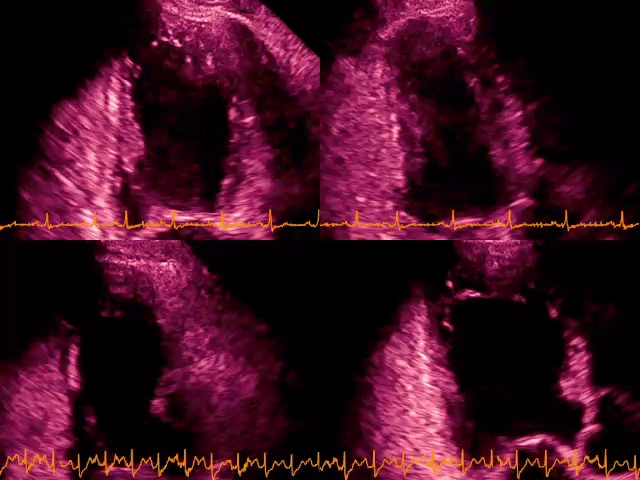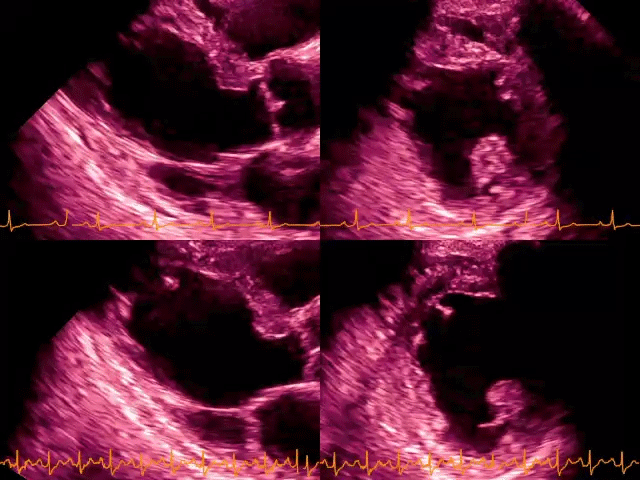The Latest ASE Guidelines for the Performance, Interpretation, and Application of Stress Echocardiography in Ischemic Heart Disease
Video 1
Video 2
New guidelines for the performance, interpretation, and application of stress echocardiography in ischemic heart disease by Pellikka et al. were published in the November 2019 online issue of the Journal of the American Society of Echocardiography.1 These guidelines represent a comprehensive update to the 2007 American Society of Echocardiography stress echocardiography guidelines and also serve to complement the more recent American Society of Echocardiography guidelines for the clinical use of stress echocardiography in nonischemic heart disease, published in 2017.2,3 The new document provides up-to-date information regarding testing protocols and standards for interpretation and includes up-to-date research on quantitative methods such as strain imaging. The document reviews appropriate use of stress echocardiography for ischemic heart disease, comparison with other modalities for assessing ischemic heart disease, safety of stress echocardiography, application of stress echocardiography in children, prognostic value of stress echocardiography, and the role of ultrasound-enhancing agents and perfusion imaging during stress echocardiography. New training requirements for performing and interpreting stress echocardiography are also summarized. The full document should be reviewed by all cardiovascular imagers and fellows in training who are involved in performing and interpreting stress echocardiograms, as well as anyone with an interest in noninvasive cardiovascular stress testing.
The document summarizes all current stress echocardiography techniques, which may be performed with a treadmill, bicycle, or pharmacologic agent. With current harmonic imaging technology and proper use of imaging-enhancing agents, stress echocardiography is highly feasible in most patients. The guidelines state that the baseline resting echocardiography performed prior to the initiation of stress should include a screening assessment of cardiac structure and function, including segmental and global ventricular function, chamber sizes, wall thicknesses, proximal aorta, and cardiac valves, unless transthoracic echocardiography (TTE) has recently been performed. These baseline images may demonstrate causes of cardiac symptoms including pericardial effusion, hypertrophic cardiomyopathy, aortic pathology, and active myocardial ischemia that may obviate the need for stress testing. Because exercise stress tests are more physiologic than pharmacologic stress tests and include prognostic findings of patient's exercise capacity, the guidelines recommend that if a patient can exercise, that is the preferred modality. In addition to the apical 4, apical 2, and parasternal long-axis views, the Intersocietal Accreditation Commission now requires apical short-axis views at rest and with stress for achieving accreditation in stress echocardiography. With respect to wall motion analysis and reporting, the guidelines acknowledge that either a 16- or 17-segment model can be utilized. If myocardial perfusion is being evaluated or if echocardiography is compared with another imaging modality, the guidelines recommend using the 17-segment model, which includes the apical cap. With respect to stress echocardiography reporting, the new guidelines state that interpretation must summarize the extent, severity, and location of wall motion abnormalities and correlation with coronary anatomy. High-risk findings, including more than one coronary distribution and cavity dilation, should be noted, as should the stress protocol used, exercise time or peak dose pharmacologic agent, maximum heart rate achieved, blood pressure response, rate pressure product, exercise capacity, and whether level of stress was adequate. Reasons for test termination, side effects of pharmacological agent used, results of stress electrocardiogram, and presence of arrhythmias, should also be noted. Global systolic function and regional wall motion assessment must be included when reporting both baseline and post stress images.
The new guidelines summarize current research examining state-of-the-art echocardiographic quantitative techniques during stress echocardiography, including spectral and tissue Doppler, myocardial strain imaging using speckle tracking techniques, three-dimensional echocardiography, and myocardial perfusion with ultrasound-enhancing agents. Quantitative analysis methods in stress echocardiography done with spectral and tissue Doppler techniques by assessing the changes in mitral E/A and E/e' ratios are useful supplements to wall motion analysis for detection of ischemia and increases in left ventricular filling pressure from diastolic dysfunction. Tissue Doppler may be useful especially in dobutamine stress testing as an adjunct for the assessment of the functional significance of disease in a single coronary artery territory. Assessment of strain during stress echocardiography is usually performed in the apical views for assessing longitudinal dysfunction. Strain is less susceptible to the effects of translational motion, and, unlike tissue Doppler imaging, regional strain values reflect local myocardial function.
Currently, myocardial strain imaging during stress echocardiography remains primarily an investigative technique and has not been shown to have an incremental increase in accuracy compared to visual assessment of wall motion, except in studies where the accuracy of visual assessment was low. If strain imaging is performed during stress echocardiography, the interpreter of stress strain images must have expertise in recognizing inadequate tracking to avoid false positive studies. The new guidelines emphasize that speckle tracking-derived longitudinal myocardial strain is especially promising during dobutamine stress echocardiography, where tracking can be well controlled. Three-dimensional stress echocardiography has been performed with both exercise and pharmacologic stress with good accuracy for detecting coronary artery disease. Its advantages include rapid acquisition of images and optimal visualization of the left ventricular apex. Challenges have been related to the lower frame rates and decreased spatial resolution as well as lack of widely available side-by-side display of rest and stress images.
Perfusion imaging techniques with myocardial contrast echocardiography are also covered in the new guidelines. Myocardial perfusion echocardiography has been shown to improve the detection of coronary artery disease compared with wall motion analysis alone. Real-time perfusion detects myocardial perfusion at a low mechanical index and real-time imaging with high frame rates. Administration of a flash or burst at a high mechanical index destroys the bubbles and evaluates its replenishment. Intermittent imaging allows for the contrast material to remain in circulation for longer and decreases the breakdown of microbubbles. A Category 3 add-on code exists for utilization of perfusion imaging as an add-on to Current Procedural Terminology for TTE and stress echocardiography, but this technique is done at a small number of experienced centers and is not approved by the US Food and Drug Administration.
The new guidelines summarize research that compares the accuracy of stress echocardiography with other noninvasive cardiovascular imaging techniques for detection of coronary artery disease. Stress echocardiography has similar sensitivity to nuclear perfusion imaging; however, stress echocardiography has higher specificity. For detection of left main or multivessel disease, stress echocardiography has greater sensitivity. Accuracy of dipyridamole is similar to dobutamine stress. False-positive stress echocardiography studies may be due to microvascular abnormalities or endothelial dysfunction and are prevalent in patients with amyloidosis or apical ballooning syndrome. Outcomes with false-positive stress echocardiography are similar to true positive results and may warrant intensive risk factor management and follow-up. PROMISE (Prospective Multicenter Imaging Study for Evaluation of Chest Pain) compared anatomic imaging using computed tomographic angiography versus functional imaging in 10,003 stable patients with new symptoms suggestive of coronary artery disease. Functional testing was performed according to the treating doctor's preference: exercise tolerance testing versus stress single-photon emission computed tomography or stress echocardiography. Stress echocardiography was performed in only 1,083 patients. Event rates in both functional and anatomic groups were comparable over a median follow-up of 25 months.4
The new guidelines also provide new information on the emerging and increasing use of stress echocardiography in the pediatric population, with emphasis on the excellent safety and tolerability of stress echocardiography in the pediatric population due to the fact that exercise stress echocardiography requires no intravenous line placement, sedation, or radiation exposure. It is generally used in patients 6 years of age or older and is increasingly being used to detect ischemia in pediatric patients with Kawasaki's disease, post-cardiac transplantation, history of radiation treatments, suspected anomalous coronary arteries, and family history of coronary artery disease.
Fellows in training who wish to acquire competency in stress echocardiography must complete a minimum of Core Cardiology Training Statement Level II training in echocardiography with a minimum of 150 TTE exams performed and 300 TTE exams interpreted. The trainee must also have interpreted a minimum of 100 stress echocardiographic studies, supervised by a Level III trained echocardiographer. Further training beyond Level II is recommended for thorough competence and experience in this modality. Physicians who interpret stress echocardiograms should interpret a minimum of 100 stress echocardiography studies per year to maintain competency, as well as actively participate in continuing medical education activities. Those wishing to perform and interpret myocardial perfusion studies during stress echocardiography or perform and interpret pediatric stress echocardiograms should seek out additional training at experienced sites.
References
- Pellikka PA, Arrruda-Olson A, Chaudhry FA, et al. Guidelines for Performance, Interpretation, and Application of Stress Echocardiography in Ischemic Heart Disease: From the American Society of Echocardiography. J Am Soc Echocardiogr 2020;33:1-41.e8.
- Pellikka PA, Nagueh SF, Elhendy AA, Kuehl CA, Sawada SG. American Society of Echocardiography recommendations for performance, interpretation, and application of stress echocardiography. J Am Soc Echocardiogr 2007;20;1021-41.
- Lancellotti P, Pellikka PA, Budts W, et al. The Clinical Use of Stress Echocardiography in Non-Ischaemic Heart Disease: Recommendations from the European Association of Cardiovascular Imaging and the American Society of Echocardiography. J Am Soc Echocardiogr 2017;30:101-38.
- Bavry AA. Prospective Multicenter Imaging Study for Evaluation of Chest Pain – PROMISE (ACC.org website). December 4, 2019. Accessed April 8, 2020. Available at https://www.acc.org/latest-in-cardiology/clinical-trials/2015/03/11/21/52/promise-imaging.
Clinical Topics: Heart Failure and Cardiomyopathies, Noninvasive Imaging, Pericardial Disease, Atherosclerotic Disease (CAD/PAD), Statins, Echocardiography/Ultrasound
Keywords: Echocardiography, Stress, Dobutamine, Exercise Test, Exercise Tolerance, Contrast Media, Coronary Artery Disease, Dipyridamole, Takotsubo Cardiomyopathy, Microbubbles, Pericardial Effusion, United States Food and Drug Administration, Current Procedural Terminology, Dilatation, Risk Factors, Prognosis
< Back to Listings


